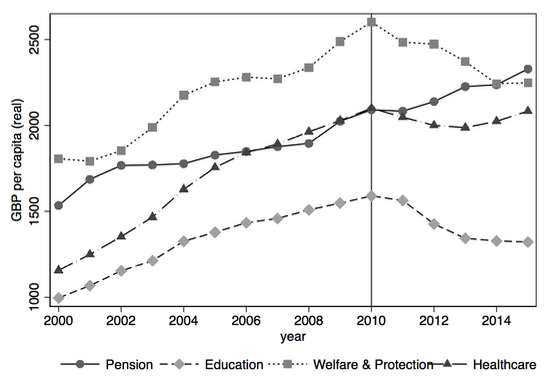https://www.epi.org/blog/restraining-the-power-of-the-rich-with-a-10-percent-surtax-on-top-0-1-percent-incomes/
Excessive wealth and power commanded by a small group of multi-millionaires and billionaires—the richest one-tenth of 1 percent—poses an existential threat to America's economic vitality, democracy, and civil society.
It's well-known by now that the richest 1 percent of American households have essentially doubled the share of national income they claim since the late 1970s. Less well-known is that inequality has even risen within the top 1 percent, with the top 10 percent of that overall group—or the top 0.1 percent—accounting for half of all income within the top 1 percent.1
The political clout of this top 0.1 percent is likely even more outsized then their share of overall income. This group's incomes overwhelmingly stem from owning financial assets, not working in labor markets.2 This means that they benefit from the preferential tax treatment given to income from wealth relative to income from work. The Trump tax cut at the end of 2017 was tailor-made for the top 0.1 percent, as its largest cuts accrue to business owners, both corporate and non-corporate.3
Countering the power wielded by the top 0.1 percent will require ambitious policy changes across a range of issues. Steeply progressive taxes have recently been proposed by a number of policymakers and economists as key ingredients in the overall policy portfolio meant to restrain the power of the super-rich. One idea that has not yet gotten the attention it deserves in this discussion is a surtax on the incomes of the top 0.1 percent. A surtax has a number of advantages as a tool for checking the power of the rich. First, it's laser-targeted on their incomes, phasing in only at the threshold of the top 0.1 percent. Second, it does not provide preferential treatment for wealth-based incomes relative to work-based incomes—it applies to every dollar of any kind over the income threshold. Third, this neutrality across types of incomes means that in the long run it would be hard to avoid or evade.
Proposal: A 10 percent surtax on the top 0.1 percent
We propose a 10 percent surtax on all income over the top 0.1 percent threshold. For simplicity, the income threshold should be defined by a taxpayer's adjusted gross income (AGI). The threshold for the tax should be determined by the IRS to have only the top 0.1 percent affected in the first year, then it should be indexed by overall inflation. In the last year of IRS dataavailable (2016), this top 0.1 percent threshold was $2.3 million. The surtax would apply to all income above AGI, including dividends and realized capital gains.
How much revenue might a 10 percent surtax on the top 0.1 percent raise?
Our preliminary estimate is that such a surtax would raise roughly $75 billion in its first year of implementation and roughly $800 billion in its first decade. The methodology for this estimate is fairly straightforward. First, we estimate how much total AGI is recorded by the top 0.1 percent.4 In 2019, we estimate that as roughly $1.17 trillion. Second, we estimate how much of the income of the top 0.1 percent of households would be exempt from the surtax by falling under the threshold, which is simply the number of tax filers in the top 0.1 percent multiplied by the tax's threshold. With roughly 150,000 filers in the top 0.1 percent estimated for 2019, this implies that about $450 billion exempt from the tax, making the overall base roughly $720 billion. Third, we multiply this base by 10 percent to get $72 billion raised in its first year. In later years, we let the number of tax filers and their AGI rise at rates that have characterized the past ten years and making similar calculations for each of those years. Over the next decade this implies revenue of roughly $800 billion.
$75 billion is a lot of money, even in the context of the federal budget. $75 billion is, for example, the cost of providing universal high-quality pre-kindergarten for all 3 and 4 year olds in the United States, plus providing substantial aid for paying for high-quality childcare for all 0-2 year olds. This sort of ambitious investment in America's children would provide huge benefits to American society and economic efficiency, and is just one example of how the income currently claimed by the very rich could be put to better use.5
1. Data on top 1 and top 0.1 percent income shares can be found in the online data on distributional national accounts maintained by Gabriel Zucman, based on work done by Zucman and co-authors Thomas Piketty and Emmanuel Saez.
2. The Piketty, Saez and Zucman (PSZ) data referenced in the footnote above indicates that non-labor income accounts for more than two-thirds of the income of the top 0.1 percent.
3. The single most-expensive component of the Trump tax cut of 2017 was the cut in corporate tax rates, which can account by itself for the entire net cost of the tax cut. Among its other provisions was a deduction for "pass-through" incomes—a form of income quite concentrated in the upper reaches of the income distribution. The PSZ data, for example, estimates that the top 0.1 percent claim almost 19 percent of all income generated by non-corporate businesses that is not paid to employees.
4. For estimated top 0.1 percent thresholds in 2019, see this table from the Tax Policy Center.
5. For an overview of the broad benefits stemming from this sort of ambitious investment in early childcare and education, see Bivens, Garcia, Gould, Weiss, and Wilson (2016).
-- via my feedly newsfeed



